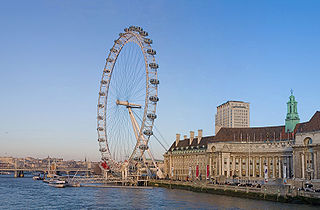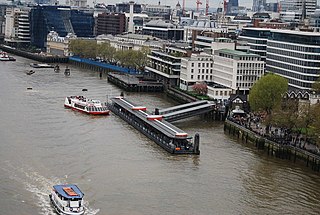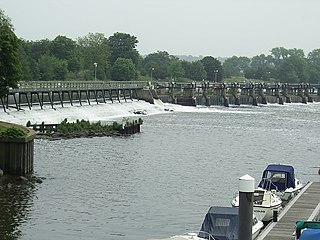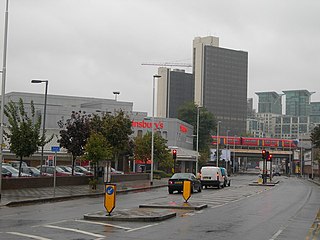
Blackfriars Bridge is a road and foot traffic bridge over the River Thames in London, between Waterloo Bridge and Blackfriars Railway Bridge, carrying the A201 road. The north end is in the City of London near the Inns of Court and Temple Church, along with Blackfriars station. The south end is in the London Borough of Southwark, near the Tate Modern art gallery and the Oxo Tower. Opened in the 1860s, it replaced an earlier bridge from the 1760s.

The South Bank is an entertainment and commercial district in central London, England on the south bank of the River Thames opposite the City of Westminster. It forms a narrow strip of riverside land within the London Borough of Lambeth and the London Borough of Southwark,. As such, the South Bank may be regarded as somewhat akin to the riverside part of an area known previously as Lambeth Marsh and North Lambeth.

Embankment is a London Underground station in the City of Westminster, known by various names during its history. It is served by the Circle, District, Northern and Bakerloo lines. On the Bakerloo line and the Charing Cross branch of the Northern line, the station is between Waterloo and Charing Cross stations; on the Circle and District lines, it is between Westminster and Temple and is in Travelcard Zone 1. The station has two entrances, one on Victoria Embankment and the other on Villiers Street. The station is adjacent to Victoria Embankment Gardens and is close to Charing Cross station, Embankment Pier, Hungerford Bridge, Cleopatra's Needle, the Royal Air Force Memorial, the Savoy Chapel and Savoy Hotel and the Playhouse and New Players Theatres.

Sir Joseph William Bazalgette CB was a British civil engineer. As Chief Engineer of London's Metropolitan Board of Works, his major achievement was the creation of a sewerage system for central London which was instrumental in relieving the city of cholera epidemics, while beginning to clean the River Thames. He later designed Hammersmith Bridge.

Waterloo Bridge is a road and foot traffic bridge crossing the River Thames in London, between Blackfriars Bridge and Hungerford Bridge and Golden Jubilee Bridges. Its name commemorates the victory of the British, Dutch and Prussians at the Battle of Waterloo in 1815. Thanks to its location at a strategic bend in the river, the bridge offers good views of Westminster, the South Bank and the London Eye to the west, and of the City of London and Canary Wharf to the east.

The Hungerford Bridge crosses the River Thames in London, and lies between Waterloo Bridge and Westminster Bridge. Owned by Network Rail Infrastructure Ltd it is a steel truss railway bridge flanked by two more recent, cable-stayed, pedestrian bridges that share the railway bridge's foundation piers, and which are named the Golden Jubilee Bridges.

The Thames Embankment is a work of 19th-century civil engineering that reclaimed marshy land next to the River Thames in central London. It consists of the Victoria Embankment and Chelsea Embankment.

Tower Pier is a pier on the River Thames, in Tower Hill, London, England. It is operated by Uber Boat by Thames Clippers and served by various river transport and cruise operators. The pier is close to Tower Bridge and is situated immediately adjacent to the southwest corner of the Tower of London.

Victoria Tower Gardens is a public park along the north bank of the River Thames in London, adjacent to the Victoria Tower, at the south-western corner of the Palace of Westminster. The park, extends southwards from the Palace to Lambeth Bridge, between Millbank and the river. It forms part of the Thames Embankment.

The Tideway is a part of the River Thames in England which is subject to tides. This stretch of water is downstream from Teddington Lock. The Tideway comprises the upper Thames Estuary including the Pool of London.

The A3036 is an A road in London, England, running from Waterloo to Wandsworth.

Embankment Pier is a pier on the River Thames in City of Westminster, London. It is located on the north bank of the river, immediately next to the Hungerford Bridge and directly outside the river entrance to Embankment Underground station. It is also conveniently close to Charing Cross railway station.

The London Eye (Waterloo) Pier is directly in front of the London Eye ferris wheel on the South Bank of the River Thames in Central London, England. It was opened as the Waterloo Millennium Pier in 2000.
Thomas Page was a British architect and civil engineer who was responsible for the design and construction of many bridges, including Westminster Bridge and the first Chelsea Bridge

The Victoria Embankment Gardens are a series of gardens on the north side of the River Thames between Blackfriars Bridge and Westminster Bridge in London.

The South Bank Lion is an 1837 sculpture in Central London. Since 1966 it has stood next to County Hall, on the South Bank of the River Thames. It is a significant depiction of a lion, along with the four that surround Nelson's Column in Trafalgar Square just across the river.

Dolphin lamp standards provide electric light along much of the Thames Embankment in London, United Kingdom. Two stylised dolphins or sturgeons writhe around the base of a standard lamp post, supporting a fluted column bearing electric lights in an opaque white globe, topped by a metal crown. Many of the lamps are mounted on granite plinths.

The Sir Joseph Bazalgette Memorial is a memorial to the Victorian engineer Sir Joseph Bazalgette, by George Blackall Simonds. It is located on the Victoria Embankment, a few feet up river from the Hungerford Bridge and Golden Jubilee Bridges, opposite the junction with Northumberland Avenue.




















